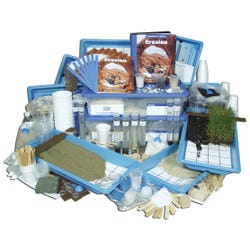Delta Science Modules Erosion Complete Kit, Edition 3, Grades 5 to 6
Description
Comprehensive, affordable and effective, Delta Science Modules Edition 3 (DSM-3) Kits provide an inquiry-based, hands-on approach to teaching a specific science topic through the use of activities and investigative equipment. Delta Science Modules Erosion Complete Kit will get your class to explore the concept of erosion, the carrying away of weathered material by wind and water. Students will discover how and why Earth’s crust is constantly changing because of erosion through a variety of activities. First, students will build stream tables and adjust the inclination to propel the erosion process. Then they will simulate flood conditions to determine the permeability and erosion resistance of different soils. Next, they will test planted and unplanted soils as erosion deterrents. Stream tables become beaches, and students will construct breakwaters to reduce shoreline erosion. They will study river sediment samples to better understand how moving water deposits streambed objects, and finally, investigate the massive impact of glacial erosion.
Along with the kit activities, the Erosion Delta Science Reader (and complementary Skillbuilders booklet that helps students practice reading/grammar/writing/vocabulary skills with the content from the Delta Science Reader) will get students to read even more about Earth’s structure. They will: find out about the slowly moving plates that make up Earth’s surface and how they are related to mountain building, trenches, earthquakes, and volcanoes; learn about physical and chemical weathering and how they contribute to soil formation; be introduced to the causes of erosion and deposition, and the landforms that are the results of these forces; read about soil conservationists and the ways they work to conserve soil and control erosion; and finally, learn about floods.
Delta Science Modules Edition 3 (DSM-3) consist of a total of 59 assorted kits ranging from Grade K to 8 levels, each with a step-by-step teacher guide, student readers, 12-14 interconnected activities, and enough equipment to serve up to 32 students. Select kits also contain a pre-paid coupon for Living materials. Educators have the flexibility to have students follow the detailed activities that are provided, or customize their own curriculum plan with the equipment provided.
Features
- Delta Science Modules are all-inclusive comprehensive science kits ranging from Grade K to 8 that investigate key science topics through the powerful combination of hands-on activities and rich content-area reading
- Comprehensive teacher guide provides background and key points for all 12 hands-on activities, as well as page-by-page suggestions, review questions, standards correlations, and writing links for use with Readers
- Science Readers for students include informative, engaging full-color photos, text, and graphics that present key information and vocabulary about the science unit (Think About…), science careers or historical biographies (People in Science), and high-interest articles or selections (Did You Know?)
- Each kit includes a thorough 3-part assessment and a Unit Test so you can accurately gauge your students' mastery of the concepts and key vocabulary
- DSM-3 kits can support your current curriculum with the step-by-step hands-on investigations, or tools can be used to tailor your own science program to meet your various students' needs, topics of interest, and state and national standards
- Equipment Kit for 32 Students with Twelve Hands-On Activities:
- Weathering
- Erosion
- The Roots of Erosion
- Rock Races
- Is It Inclined to Erode?
- Erosion and Flooding
- Water In, Water Out
- Two Soil Types
- River Sediment
- Shoreline Erosion
- Wind Erosion
- Erosion and Glaciers
- 1 Teacher Guide in Three-Ring Spiral Binder
- 8 Copies of Nonfiction "Erosion" Science Reader (16-20 Pages Each) for Grade 5 to 6
- 1 Skillbuilders Packet for Teaching a Science-Literacy Connection Includes:
- 32 Consumable Student Booklets (4 Pages Each)
- Teaching Information
- Sample Answers






